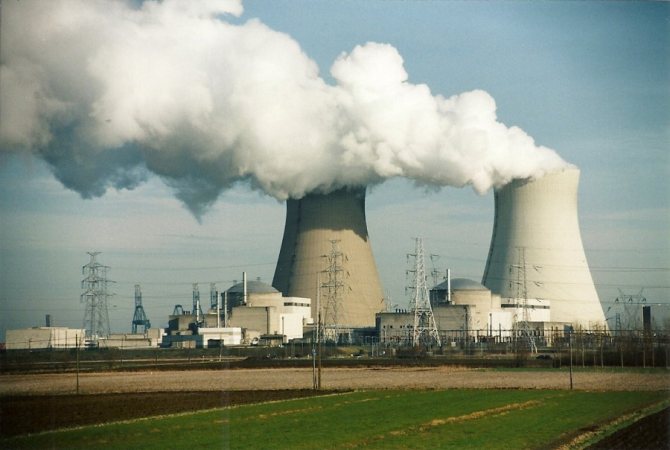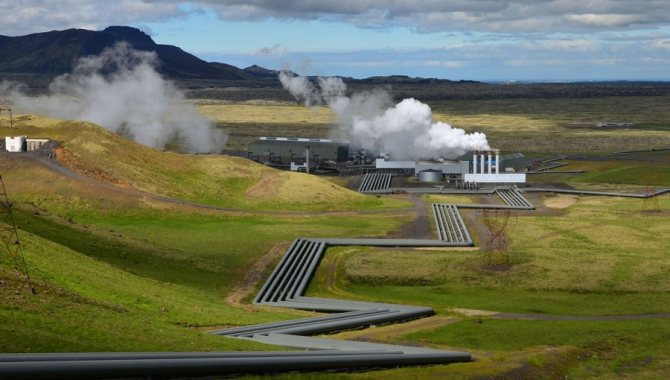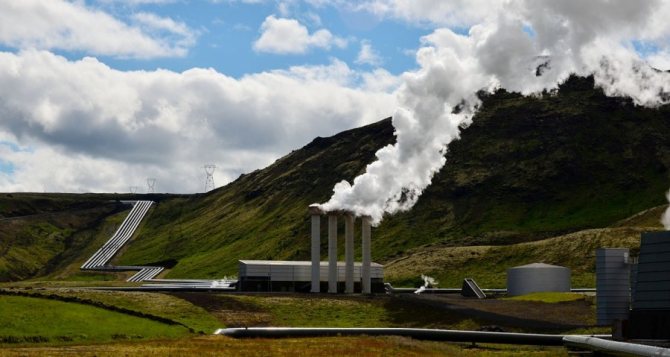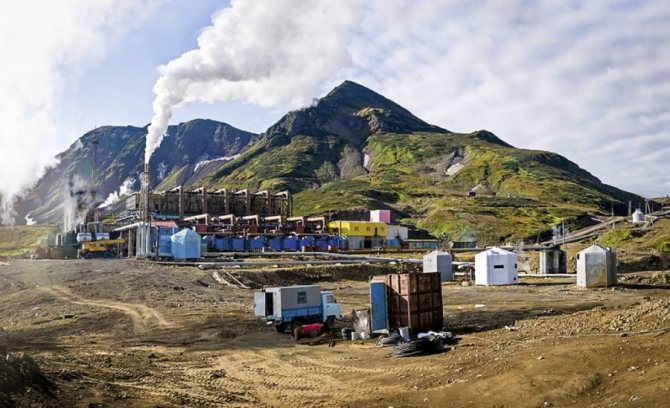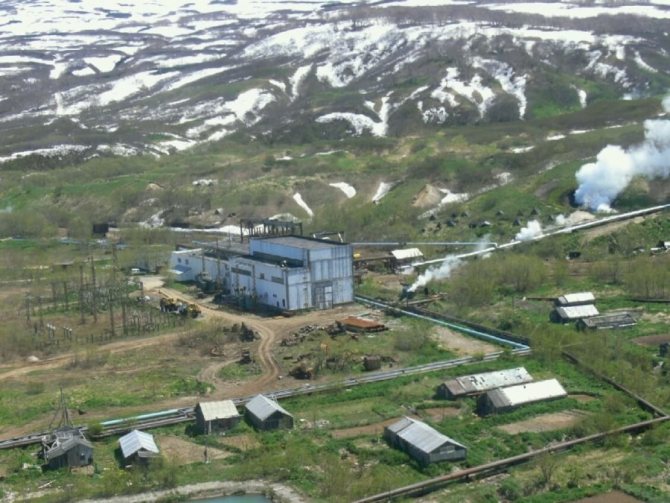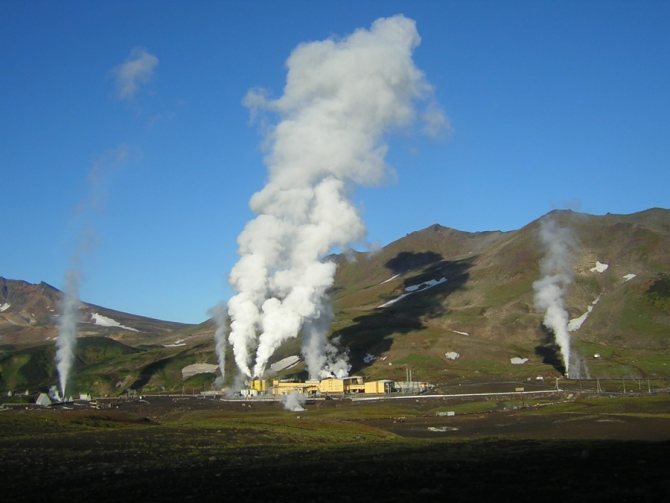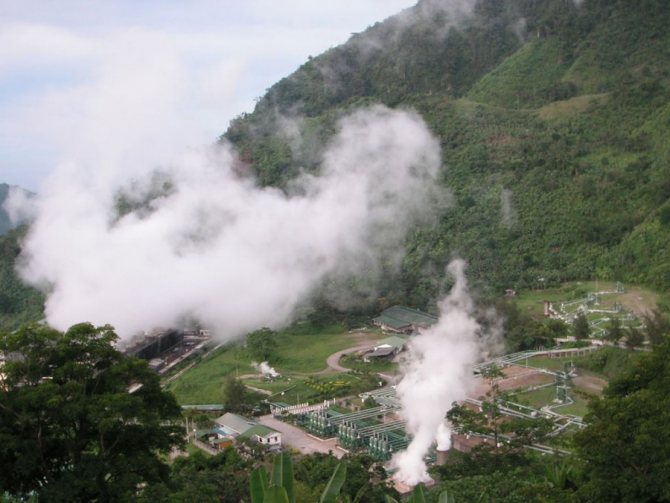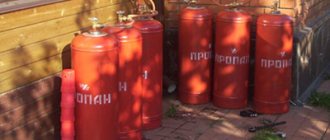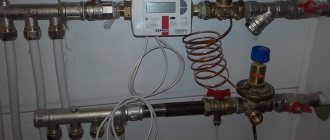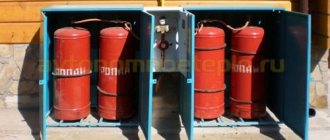Geothermal energy
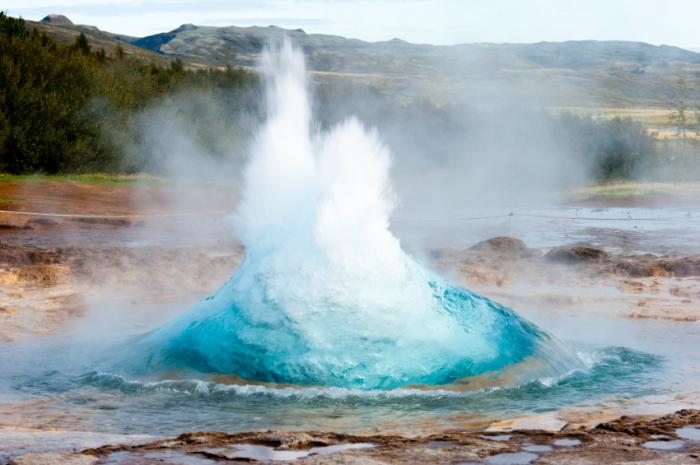
Already from the name it is clear that it represents the warmth of the earth's interior. Under the earth's crust is a layer of magma, which is a fiery liquid silicate melt. According to research data, the energy potential of this heat is much higher than the energy of the world's reserves of natural gas, as well as oil. Magma - lava comes to the surface. Moreover, the greatest activity is observed in those layers of the earth on which the boundaries of tectonic plates are located, as well as where the earth's crust is characterized by thinness. The geothermal energy of the earth is obtained in the following way: the lava and the water resources of the planet come into contact, as a result of which the water begins to heat up sharply. This leads to the eruption of a geyser, the formation of the so-called hot lakes and underwater currents. That is, precisely to those natural phenomena, the properties of which are actively used as an inexhaustible source of energy.
Efficiency of a geothermal power plant
In fact, one cannot say that geothermal power plants are very efficient, since their efficiency is only 7-10 percent. This is very small compared to facilities where energy is extracted from burning fuel. That is why you cannot just dig a hole, put a pipe in it and go to rest. The system must be highly efficient and use multiple cycles for higher productivity, otherwise the energy received will not even be enough to operate the pumps used to deliver fluid to the surface.
The key to the success of geothermal power plants, compared to wind and solar, is their consistency. They are able to work 24/7 at the same intensity, using less energy to work than they produce at the output. An additional plus is the possibility of obtaining heat used for heating houses and objects in the nearest area. And for all this, you do not need to burn expensive fuel.
Artificial geothermal springs
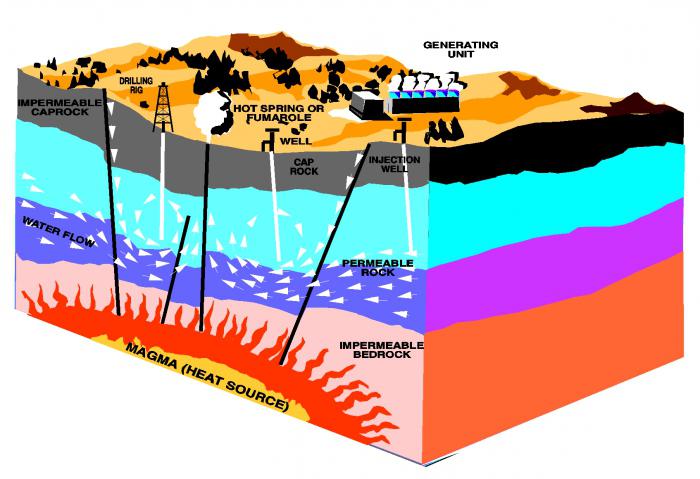

The energy contained in the bowels of the earth must be used wisely. For example, there is an idea to create underground boilers. To do this, you need to drill two wells of sufficient depth, which will be connected at the bottom. That is, it turns out that in almost any corner of the land it is possible to obtain geothermal energy industrially: cold water will be pumped into the reservoir through one well, and hot water or steam will be extracted through the second. Artificial heat sources will be beneficial and rational if the resulting heat provides more energy. Steam can be directed to turbine generators, which will generate electricity.
Of course, the selected heat is only a fraction of what is available in the total reserves. But it should be remembered that the deep heat will constantly replenish due to the processes of radioactive decay, compression of rocks, stratification of the bowels. According to experts, the earth's crust accumulates heat, the total amount of which is 5,000 times greater than the calorific value of all the fossil resources of the earth as a whole. It turns out that the operating time of such artificially created geothermal stations can be unlimited.
Global distribution of geothermal energy
The thickness of the earth's crust, the dependence of the temperature of its inner layers on depth and, accordingly, the availability of geothermal energy in different regions of the planet vary greatly.
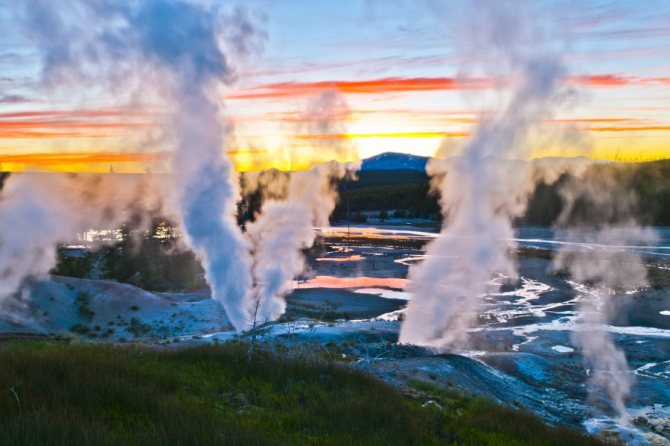

Above the boundaries of lithospheric plates, in mountainous regions and on the coasts of the oceans, sources of geothermal energy are much more accessible. In the literature there are many maps, diagrams and figures illustrating this unevenness.
A numerical indicator of the availability of geothermal energy can be the gradient of the temperature rise of the environment depending on the depth. According to this indicator, the regions of the Earth can be divided into several categories:
- Geothermal, located near the boundaries of the continental plates. Temperature gradient over 80 ° C / km. Examples are the Larderello commune located in the Italian province of Pisa, where the world's first geothermal power plant is built, areas with hot geysers in Iceland, Kamchatka, the Valley of Geysers in America's Yellowstone National Park.
- Semi-thermal with a temperature gradient of 40-80 ° C / km. Some parts of France can serve as an example. Common, with a temperature gradient of less than 40 ° C / km - most of the Earth's surface.
The distribution of regions with a high occurrence of high-temperature layers of the crust over the Earth's surface largely determines the concentration in certain regions of industrial enterprises using natural heat. So, in addition to the already mentioned Iceland and industrialized Japan, a large share of such enterprises is located in the Philippines.
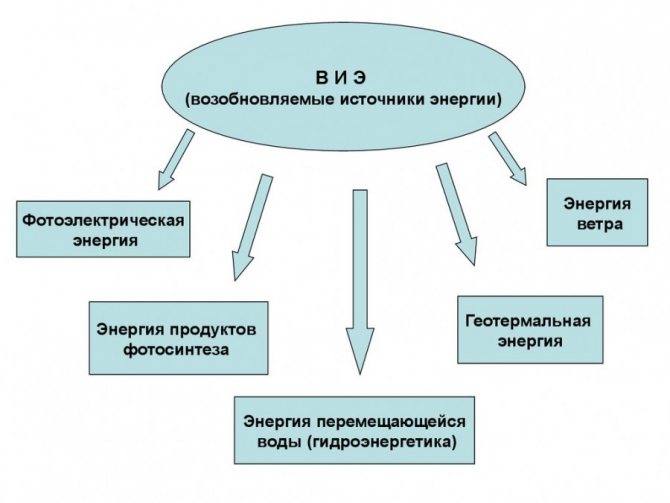

In Russia, in addition to the Far East coast of Sakhalin and the Kuril Islands, areas with higher geothermal activity can be almost completely identified with mountainous areas along the southern borders of the country, in the Caucasus and Eastern Siberia.
Features of sources
Sources that provide geothermal energy are almost impossible to use in full. They exist in more than 60 countries of the world, with the majority of land-based volcanoes in the Pacific Volcanic Ring of Fire. But in practice, it turns out that geothermal sources in different regions of the world are completely different in their properties, namely, average temperature, mineralization, gas composition, acidity, and so on.
Geysers are sources of energy on Earth, the peculiarity of which is that they spew boiling water at regular intervals. After the eruption has occurred, the pool becomes free of water, at its bottom you can see a channel that goes deep into the ground. Geysers are used as energy sources in regions such as Kamchatka, Iceland, New Zealand and North America, and solitary geysers are found in several other areas.
Prospects for geothermal power plants
More than a hundred years after the first demonstration of the possibilities of using geothermal energy, stations operating on this “fuel” are promising and irreplaceable for some regions. In Russia, for example, almost all stations are located in Kamchatka. In the United States, we are talking about California, and in Germany, about some of the Alpine regions.
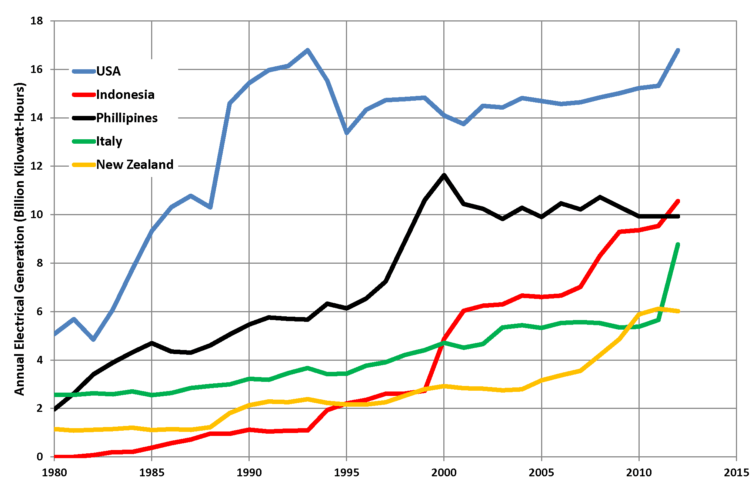

Countries are leaders in the production of energy from geothermal sources.
The five leaders in terms of the volume of energy produced by GeoTPPs include the USA, Indonesia, the Philippines, Italy and New Zealand. It is easy to see that these are countries with completely different levels of development. It turns out that geothermal energy is available to everyone and everyone is interested in it. As technology advances, plant efficiency increases and supplies of non-renewable energy sources decrease, geothermal energy will become more and more in demand.
For those who are worried about the temperature of the planet, it should be said that at a temperature of the center of the Earth at least 6800 degrees Celsius, it cools down by only 300-500 degrees in a billion years. I think there is no need to worry about this.
Where does the energy come from?
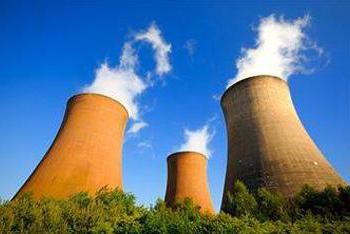

Uncooled magma is located very close to the earth's surface. Gases and vapors are released from it, which rise and pass along the cracks. Mixing with groundwater, they cause their heating, they themselves turn into hot water, in which many substances are dissolved.Such water is released to the surface of the earth in the form of various geothermal springs: hot springs, mineral springs, geysers, and so on. According to scientists, the hot bowels of the earth are caves or chambers connected by passages, cracks and channels. They are just filled with groundwater, and magma centers are located very close to them. In this way, the thermal energy of the earth is formed in a natural way.
Geothermal heating at home
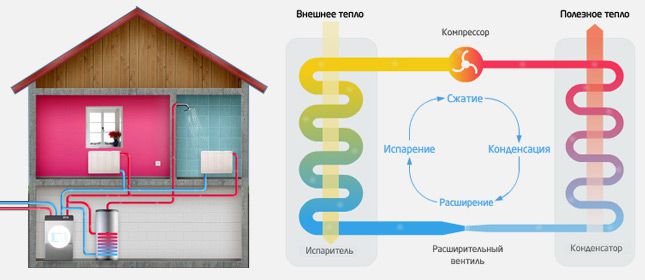

Geothermal heating scheme
First, you need to understand the principles of obtaining thermal energy. They are based on the temperature rise as you go deeper into the ground. At first glance, the increase in the degree of heating is insignificant. But thanks to the advent of new technologies, heating a house using the heat of the earth has become a reality.
The main condition for organizing geothermal heating is a temperature of at least 6 ° C. This is typical for middle and deep layers of soil and water bodies. The latter are highly dependent on the external temperature indicator, therefore they are extremely rarely used. How is it practically possible to organize the heating of a house with the energy of the earth?
To do this, it is necessary to make 3 circuits filled with liquids with different technical characteristics:
- Outer... More often antifreeze circulates in it. Its heating to a temperature not lower than 6 ° С occurs due to the energy of the earth;
- Heat pump... Without it, heating from the energy of the earth is impossible. The heat carrier from the external circuit with the help of a heat exchanger transfers its energy to the refrigerant. Its evaporation temperature is less than 6 ° C. After that, it enters the compressor, where, after compression, the temperature rises to 70 ° C;
- Inner contour... A similar scheme is used to transfer heat from the compressed refrigerant to water in the overcoming system. Thus, heating from the bowels of the earth takes place at minimal cost.
Despite the obvious advantages, such systems are rare. This is due to the high costs for the purchase of equipment and the organization of an external circuit for heat intake.
It is best to entrust the calculation of heating from the heat of the earth to professionals. The efficiency of the entire system will depend on the correctness of the calculations.
Electric field of the Earth
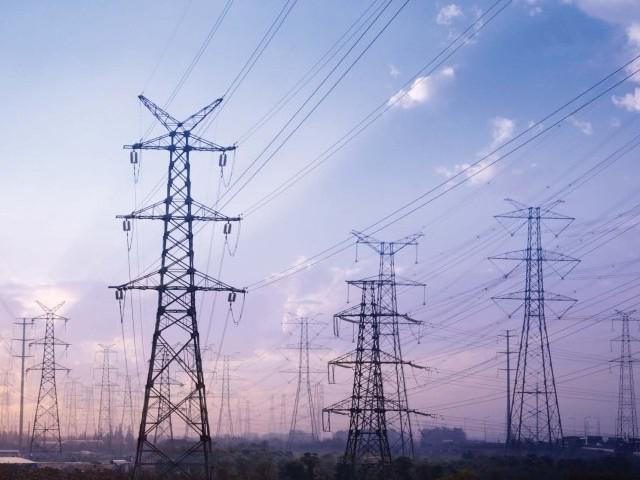

There is another alternative energy source in nature, which is distinguished by renewability, environmental friendliness, and ease of use. True, until now this source is only being studied and not applied in practice. So, the potential energy of the Earth is hidden in its electric field. Energy can be obtained in this way by studying the basic laws of electrostatics and the characteristics of the Earth's electric field. In fact, our planet from an electrical point of view is a spherical capacitor charged up to 300,000 volts. Its inner sphere has a negative charge, and the outer one, the ionosphere, is positive. The Earth's atmosphere is an insulator. Through it there is a constant flow of ionic and convective currents, which reach a force of many thousands of amperes. However, the potential difference between the plates does not decrease in this case.
This suggests that there is a generator in nature, the role of which is to constantly replenish the leakage of charges from the capacitor plates. The role of such a generator is played by the Earth's magnetic field, rotating with our planet in the flow of the solar wind. The energy of the Earth's magnetic field can be obtained just by connecting an energy consumer to this generator. To do this, you need to perform a reliable grounding installation.
How is it useful?
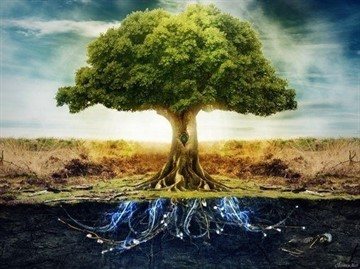

The earth is a symbol of the material world. Of all the elements, it is the earth that is closest to man. It is a reviving force, center and support for all living things. She gives life, feeds, preserves, takes care of people.
Earth energy is directed to nourish all parts of the body at the molecular level. It allows you to restore inner balance, to feel a connection with your family and receive support from it.It gives a person a basic quality - sustainability.
It plays an important role in maintaining health, in the normalization of the material, spiritual and sexual spheres of life. With the help of earthly energy, you can develop such qualities as responsiveness, mercy, kindness, harmony, calmness.
The lack of energy from the earth leads a person to a depressed and nervous state. The joy of life disappears, stability and stability disappear. Plans collapse, problems begin in the sexual sphere and in the field of finance.
Earth energy is especially necessary for women. It gives the ability to experience joy from feeling yourself in your body, from movements, from sexual relations.
Grounding gives energy strength, allows you to act on the basis of internal needs. Earthly energy helps a woman to solve material problems, to remain a wise, caring and loving mother and wife.
Renewable sources
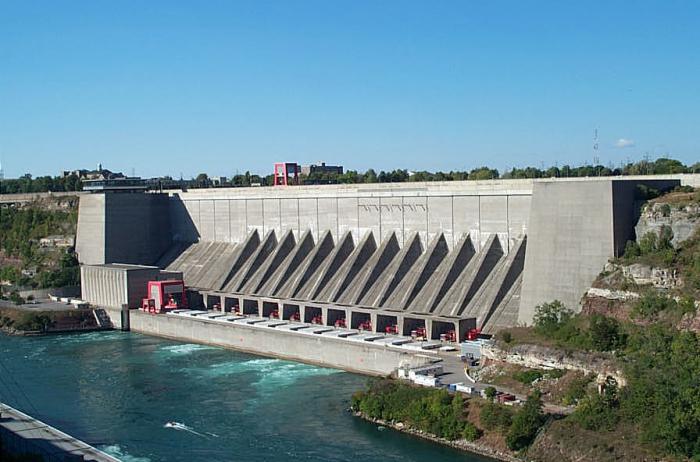

As the population of our planet grows steadily, we need more and more energy to support the population. The energy contained in the bowels of the earth can be very different. For example, there are renewable sources: wind, solar and water energy. They are environmentally friendly, and therefore you can use them without fear of causing harm to the environment.
Low grade Earth heat energy and heat pumps
The sources of low-potential energy of the Earth's heat are solar radiation and thermal radiation from the heated bowels of our planet. Currently, the use of such energy is one of the most dynamically developing areas of energy based on renewable energy sources.
The heat of the Earth can be used in various types of buildings and structures for heating, hot water supply, air conditioning (cooling), as well as for heating paths in the winter season, preventing icing, heating fields in open stadiums, etc. utilizing the heat of the Earth in heat supply and air conditioning systems are designated as GHP - "geothermal heat pumps" (geothermal heat pumps). The climatic characteristics of the countries of Central and Northern Europe, which, together with the USA and Canada, are the main regions for using the low-potential heat of the Earth, determine this mainly for heating purposes; cooling the air even in summer is relatively rare. Therefore, unlike the USA, heat pumps in European countries operate mainly in heating mode. In the United States, they are more often used in air heating systems combined with ventilation, which allows you to both heat and cool the outside air. In European countries, heat pumps are commonly used in hot water heating systems. Since their efficiency increases with a decrease in the temperature difference between the evaporator and the condenser, underfloor heating systems are often used to heat buildings, in which a coolant circulates at a relatively low temperature (35–40 ° C).
Energy of water
This method has been used for many centuries. Today, a huge number of dams, reservoirs have been built, in which water is used to generate electricity. The essence of this mechanism is simple: under the influence of the flow of the river, the wheels of the turbines rotate, respectively, the energy of the water is converted into electricity.
Today there are a large number of hydroelectric power plants that convert the energy of the flow of water into electricity. The peculiarity of this method is that hydropower resources are renewed, respectively, such structures have a low cost. That is why, despite the fact that the construction of hydroelectric power plants has been going on for quite a long time, and the process itself is very costly, nevertheless, these structures significantly outperform power-intensive industries.
The power of volcanoes: how the heat of the earth provides people with energy
We all know well that alternative energy is safer for the environment than traditional energy. We know that its sources are the Sun, wind, tides, biomass. However, in the modern information world, little attention is paid to another source of alternative energy - volcanoes. In part, the gains on this front are not so significant.
But if we learned to use the power of volcanoes at least 50 percent, we would not need either gas or oil to obtain light and heat. The fact is that volcanoes can give people such an amount of energy that exceeds the energy from the world's gas and oil reserves by a factor of thousands.
Where does the energy of volcanoes come from?
To some extent, our planet can be compared to an egg: first there is a “hard shell” called the lithosphere, then “viscous protein” - the mantle, and a dense (presumably) “yolk” - the core.
The thickness of the "hard shell" on land and in the ocean varies: in the first case, it reaches 50-70 km, in the second, it can be 5-20 km. The entire lithosphere is divided into blocks, which together resemble a mosaic cut by faults and cracks - scientists call such blocks lithospheric plates.
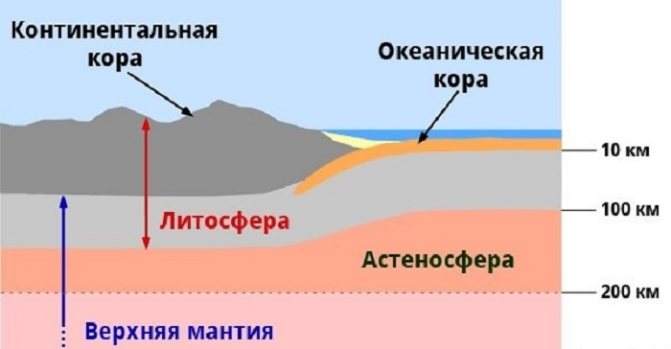

Photo: geographyofrussia.com/ The internal structure of the Earth
As for the mantle, it is very hot, its temperature varies from several hundred to several thousand degrees: the closer to the core, the higher the temperature, and, accordingly, the closer to the lithosphere, the lower. The temperature difference is the reason why substances in the mantle mix: colder masses go down, and hot ones rise up. Although the mantle is heated to high temperatures, it is not liquid, but, as we said above, viscous due to the strong pressure inside the Earth.
The blocks of our "hard shell" lie on the mantle, slightly sinking into it under the weight of their weight. When the heated mantle mass rises up to the surface, it begins to move under the lithospheric “mosaic” plates, forcing them to involuntarily follow it.
If at the same time a part of one plate is pressed from above by another lithospheric block, then this part gradually sinks deeper and deeper into the mantle and melts, as a result of which a liquid magma
- molten rocks with water vapor and gas.
Since magma is lighter than the surrounding rocks, it begins to slowly rise upward and accumulate in magma chambers along the collision lines of the plates. Its temperature at this moment is approximately 900-1200 ° C.
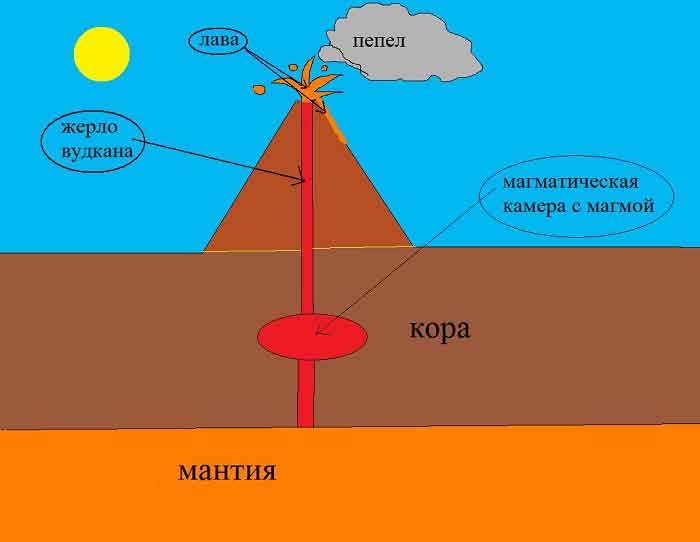

Photo: shilchik.livejournal.com/ When magma reaches the surface, it cools, loses gases and becomes lava
The behavior of red-hot magma in such chambers can to some extent be compared with yeast dough: magma increases in volume, occupies all free space and rises from the depths along cracks, trying to break free (if magma is rich in aluminum and silicon, it can solidify right in crust and form deep igneous rocks). As the dough lifts the lid of the pot and flows out over the edge, so magma heaves and then breaks through the earth's crust in the weakest places and breaks out to the surface. This is how eruptions take place.
When the rock melts deep underground, in the course of chemical reactions and radioactive decay of elements, heat is released, which, like magma, rises to the ground and goes out. The heat flux density decreases as it approaches the surface.
The heat from the bowels of the earth is of interest to many researchers, because it can be used to provide people with energy for a huge amount of time. This type of energy in science is called geothermal.
How man tries to tame the energy of volcanoes
The heat flux that reaches the surface in most areas of the planet is small: its power is approximately 0.06 watts per square meter, or something in the region of 355 Wh / m2 per year. Scientists attribute this to a special geological structure and, possibly, low thermal conductivity of rocks on a large part of the Earth. But if these heat fluxes go out through cracks and faults, as well as existing volcanoes in zones of increased volcanic and seismic activity of the planet, they, as a rule, are hundreds of times more powerful than ordinary ones, since a less thick “shell” is encountered on their way, and, consequently, thermal spray is not as strong. Both the eruptions themselves and hot underground waters bring to the surface heat flows, sometimes this occurs in the form of steam (the waters lie at depths to which we can get, where they are heated by magma, usually to a state of steam).
Such active areas attract the attention of geologists all over the world, and it is here, near volcanoes, that special geothermal stations are built to tame underground heat and generate electricity and energy from it for heating houses.
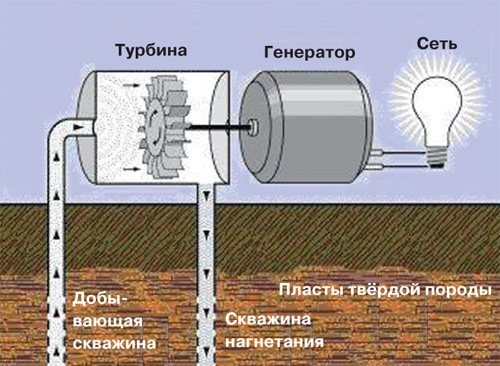

Photo: elementy.ru/ The principle of operation of a geothermal power plant on dry steam
As we said earlier, the closer to the core of the planet, the higher the temperature becomes, which means that the power of the heat flow increases. For example, in the magma chamber, which is located at a depth of just over 5 kilometers under the Avachinsky volcano in Kamchatka, approximately 7 x 10 (to the 14th power) kcal / km3 of heat has been accumulated, which would provide energy for hundreds of thousands of homes.
Therefore, when building geothermal plants, engineers try to drill wells as deep as possible, this allows you to get to higher temperatures and get more powerful heat flows in the form of dry and wet steam or hot water, which then in a “finished” form go to evaporators or turbines , and then into generators.
During drilling, the temperature rises with each kilometer by an average of 20-30 ° C, and, depending on the geological structure, in different regions of the Earth, the rate of temperature rise may differ.
Interestingly, hot water with a temperature of 20-30 to 100 ° C is suitable for space heating, and from 150 ° C for generating electricity.
At the moment, the deepest geothermal wells that humans have been able to drill are only 2-4 km long. Thanks to them and geothermal power plants, for example, in Russia and the United States, in 2010, it was possible to obtain an installed power capacity of slightly more than 80 MW and 3086 MW, respectively. Interestingly, a conventional nuclear power plant produces an average of 1000-2000 MW per year.
Currently, projects are being considered that allow cutting holes up to 5 kilometers deep directly in volcanoes and extracting energy from magma (remember that the temperature at such a depth in magma chambers can reach 900-1200 ° C). Experiments show that today there are building products that can be successfully used in magma chambers, in particular, Inconel 718 and 310 heat-resistant alloys (they can be used up to 980 ° C).
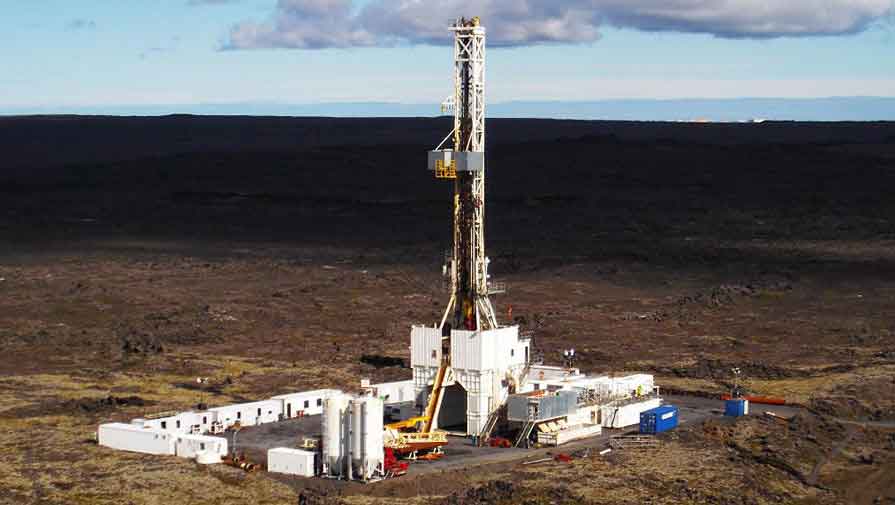

Photo: gazeta.ru/ Drilling a geothermal well in Iceland
In 2000, the Iceland Deep Drilling Project was launched in Iceland. Nine years later, while drilling the first well, specialists managed to reach the magma chamber at a depth of 2 kilometers and create the hottest geothermal flow at 450 ° C.
In 2020, Iceland began to drill a second well at a depth of 5 kilometers using the Tor drilling rig (named after the Scandinavian god of thunder and storm). Work went on on the Reykjanes Peninsula and ended a year later. With this installation, the Icelanders were able to penetrate 4659 meters down into deep water layers in contact with magma, and receive a flow of 427 ° C.
At such a depth, water is in a supercritical state (that is, it does not behave like a liquid or a gas), it can store a huge amount of heat and produce several times more energy than dry and wet steam or underground hot water.
This well, according to some scientists, is capable of delivering up to 50 MW of power, that is, 10 times the power of a conventional geothermal well, and provide 50 thousand more homes with energy.
Geothermal projects in Russia and the USA
Iceland is not the only country in the world to use volcanic energy. Geothermal springs are being developed in Italy, Japan, Mexico, Russia, USA, Hawaii, African countries, that is, in those places where there is volcanic and seismic activity.
There are 5 geothermal power plants in Russia, located mainly in Kamchatka. The most powerful of them is Mutnovskaya. In 2020, its installed power capacity was 50 MW.
However, this is only a small fraction; Russia practically does not use its potential in this area. According to research by scientists, our country has 10 times more geothermal resources than oil and gas reserves. Only at the expense of one geothermal form of energy could Russia fully satisfy its “energy appetite”. But for economic and technical reasons, this cannot be done. Today, the share of geothermal energy in the country's total energy sector remains negligible.
In the United States, things are much better. Geothermal energy is developing there. For example, 116 kilometers from San Francisco, on the border of California's Lake and Sonoma counties, only a group of geothermal power plants (there are 22 in total) is capable of receiving an installed capacity of up to 1,520 MW per year.
American companies are world leaders in the geothermal energy industry, even though this sector has only recently started to emerge in the United States. According to the US Department of Commerce, exports of geothermal energy from this country are greater than imports (the same situation is with technologies for this type of energy).
Problems with the extraction of energy from the bowels of the Earth
Geothermal energy belongs to environmentally friendly sources and special power plants for its production do not require huge areas (on average, one station occupies 400 square meters per 1 GW of generated energy).
However, it still has some eco-friendly downsides. In particular, the formation of solid waste, certain chemical pollution of water and soil, as well as thermal pollution of the atmosphere.
The main source of chemical pollution is hot underwater waters, which quite often contain a large amount of toxic compounds, which in turn creates a problem for the disposal of waste water.
Or, for example, well drilling. During this process, the same danger arises as when drilling a conventional well: the soil and vegetation cover is destroyed.
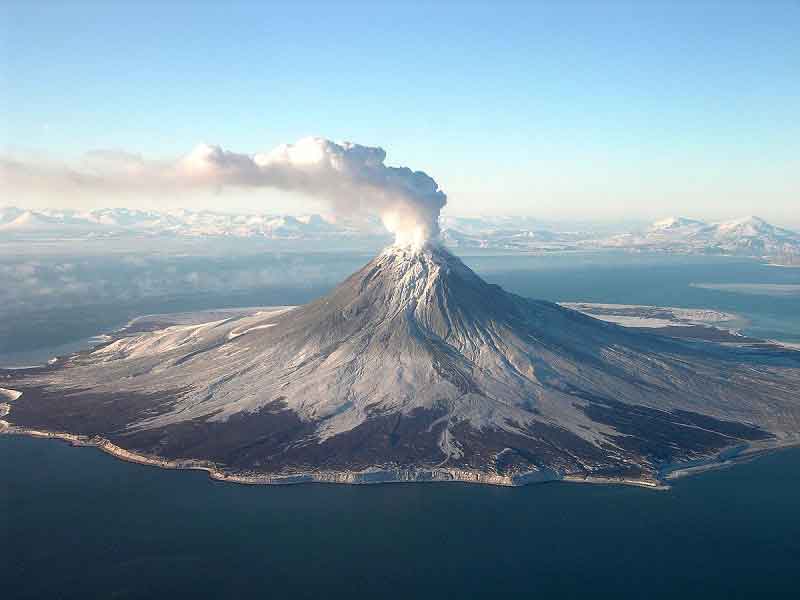

Photo: wikipedia.org/ Gas plume from Augustine volcano in 2006, located on the island of the same name near Alaska
Also, the steam involved in the operation of geothermal power plants can contain ammonia, carbon dioxide and other substances, and when released into the atmosphere, become a source of its pollution.
True, these emissions are much lower than at thermal power plants. If we compare with carbon dioxide emissions, then per kWh of generated electricity, they amount to 380 g at a geothermal station versus 1042 for coal and 453 g for gas.
The problem with waste water has already received a simple solution. With low salinity after cooling, water is pumped back into the aquifer through an injection well without harming nature, which is currently used.
Geothermal energy in the future in Russia
Volcanoes are a huge source of energy under our noses, which is enough for everyone with interest.To master the warmth of the Earth's interior, we need to learn how to drill deep wells and transfer underground heat to the surface without any problems. It will be difficult to do this without investments, mutual assistance of states, and introduction of innovative ideas.
Nature gives us huge reserves of underground heat - an alternative source of energy that can be used for the benefit of man and not to the detriment of the planet, and we, unfortunately, ignore this gift for two simple reasons: greed and unwillingness to take responsibility for what we do with the environment.
Found a bug? Please select a piece of text and press Ctrl + Enter.
+3
0
Energy of the sun: modern and future-proof
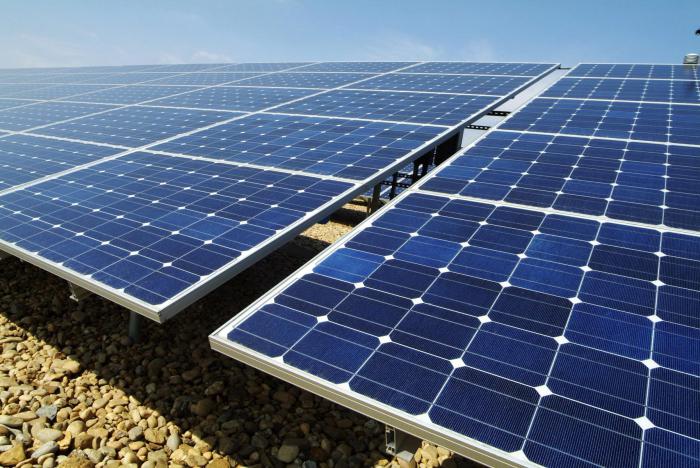

Solar energy is obtained using solar panels, but modern technologies allow using new methods for this. The world's largest solar power plant is a system built in the California desert. It fully powers 2,000 houses. The design works as follows: the sun's rays are reflected from the mirrors, which are sent to the central boiler with water. It boils and turns into steam that drives the turbine. She, in turn, is connected to an electric generator. Wind can also be used as the energy that the Earth gives us. The wind blows the sails, turns the mills. And now it can be used to create devices that will generate electrical energy. By rotating the blades of the windmill, it drives the turbine shaft, which, in turn, is connected to an electric generator.
Applications
The exploitation of geothermal energy dates back to the 19th century. The first was the experience of Italians living in the province of Tuscany, who used warm water from sources for heating. With her help, new wells drilling rigs worked.
Tuscan water is rich in boron and when evaporated turned into boric acid, the boilers worked on the heat of their own waters. At the beginning of the 20th century (1904), the Tuscans went further and launched a steam power plant. The example of the Italians became an important experience for the USA, Japan, Iceland.
Agriculture and horticulture
Geothermal energy is used in agriculture, healthcare and households in 80 countries around the world.
The first thing that thermal water has been and is used for is heating greenhouses and greenhouses, which makes it possible to harvest vegetables, fruits and flowers even in winter. Warm water also came in handy for watering.
Growing crops in hydroponics is considered a promising direction for agricultural producers. Some fish farms use heated water in artificial reservoirs to breed fry and fish.
We advise you to read: What is the best way to dispose of a Christmas tree?
These technologies are common in Israel, Kenya, Greece, Mexico.
Industry and housing and communal services
More than a century ago, hot thermal steam was already the basis for generating electricity. Since then, it has served industry and utilities.
In Iceland, 80% of housing is heated by thermal water.
Three schemes of electricity production have been developed:
- Straight line using water vapor. The simplest: it is used where there is direct access to geothermal vapors.
- Indirect, does not use steam, but water. It is fed to the evaporator, converted into steam by a technical method and sent to the turbine generator.
Water requires additional purification, because it contains aggressive compounds that can destroy the working mechanisms. Waste, but not yet cooled down steam is suitable for heating needs.
- Mixed (binary). Water replaces fuel, which heats another fluid with higher heat transfer. It drives the turbine.
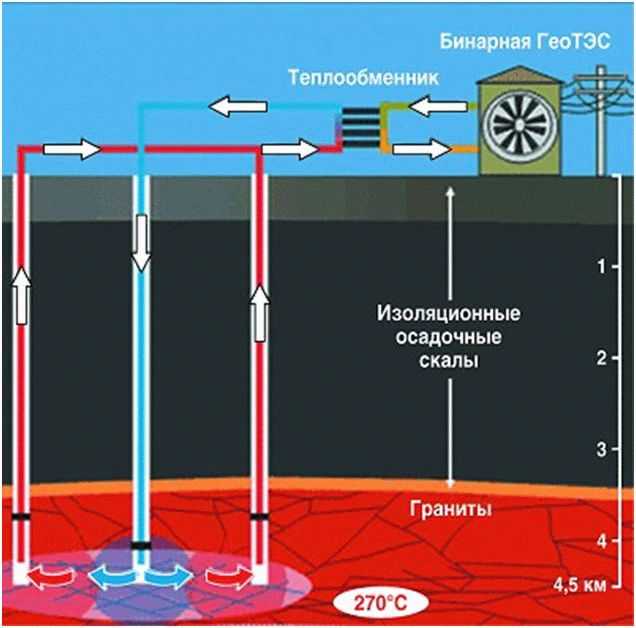

The binary system employs a turbine, which is activated by the energy of heated water.
Hydrothermal energy is used by the USA, Russia, Japan, New Zealand, Turkey and other countries.
Geothermal heating systems for home
A heat carrier heated to +50 - 600C is suitable for heating housing, geothermal energy meets this requirement. Cities with a population of several tens of thousands of people can be heated by the warmth of the earth's interior. As an example: heating of the city of Labinsk, Krasnodar Territory, runs on natural terrestrial fuel.
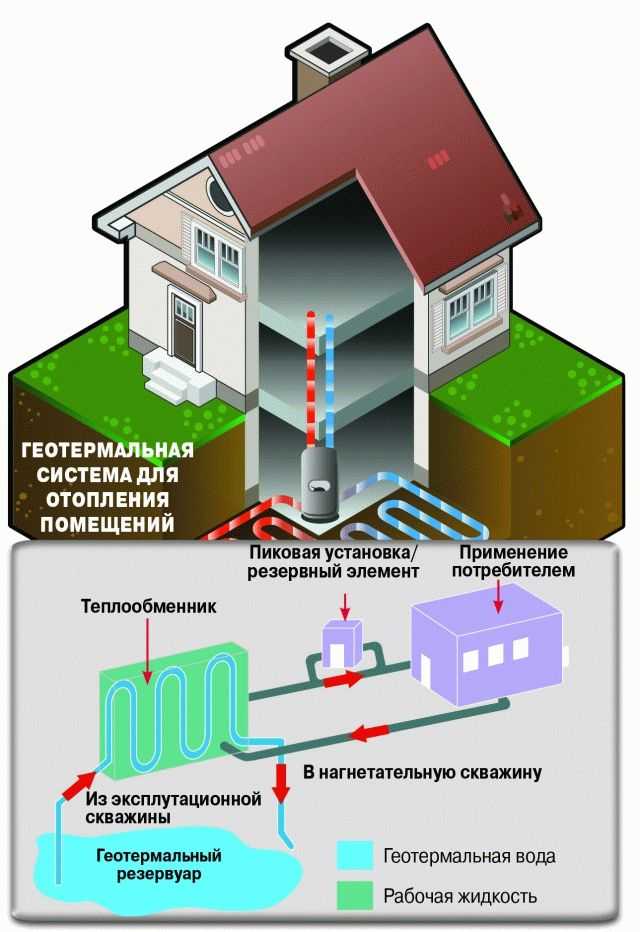

Diagram of a geothermal system for heating a house
No need to waste time and energy on heating water and building a boiler room. The coolant is taken directly from the geyser source. The same water is also suitable for hot water supply. In the first and second cases, it undergoes the necessary preliminary technical and chemical cleaning.
The resulting energy costs two to three times cheaper. Installations for private houses appeared. They are more expensive than traditional fuel boilers, but in the process of operation they justify the costs.
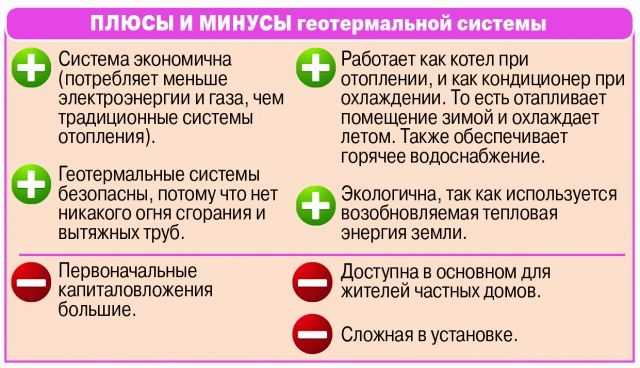

The advantages and disadvantages of using geothermal energy to heat a home.
Inner energy of the Earth
It appeared as a result of several processes, the main of which are accretion and radioactivity. According to scientists, the formation of the Earth and its mass took place over several million years, and this happened due to the formation of planetesimals. They stuck together, respectively, the mass of the Earth became more and more. After our planet began to have modern mass, but was still devoid of atmosphere, meteoric and asteroid bodies fell on it without hindrance. This process is precisely called accretion, and it led to the release of significant gravitational energy. And the larger the bodies fell on the planet, the greater the amount of energy released, contained in the bowels of the Earth.
This gravitational differentiation led to the fact that substances began to stratify: heavy substances simply drowned, and light and volatile ones floated up. Differentiation also affected the additional release of gravitational energy.
Atomic Energy
The use of the energy of the earth can happen in different ways. For example, with the construction of nuclear power plants, when thermal energy is released due to the disintegration of the smallest particles of matter of atoms. The main fuel is uranium, which is contained in the earth's crust. Many believe that this particular method of obtaining energy is the most promising, but its application is fraught with a number of problems. First, uranium emits radiation that kills all living organisms. In addition, if this substance enters the soil or atmosphere, then a real man-made disaster will arise. We are still experiencing the sad consequences of the accident at the Chernobyl nuclear power plant. The danger lies in the fact that radioactive waste can threaten all living things for a very, very long time, whole millennia.
Chemical energy
Through
Chemical energy is stored in bonds between atoms.
Chemical energy is a form potential energy that is stored in bonds between atoms as a result of the forces of attraction between them.
During a chemical reaction, one or more compounds called reagents are converted into other compounds called products. These transformations are due to the breaking or formation of chemical bonds that cause changes in chemical energy.
Energy is released when bonds are broken during chemical reactions. This is what is known as exothermic reaction... For example, cars use the chemical energy of gasoline to generate heat energy, which is used to drive the car. Likewise, food stores chemical energy that we use by living things to function.
When connections are made, energy is required; it endothermic reaction... Photosynthesis is an endothermic reaction, the energy of which comes from the sun.
New time - new ideas
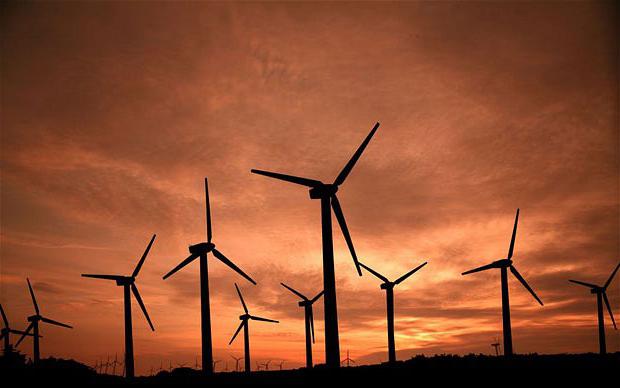

Of course, people do not stop there, and every year more and more attempts are made to find new ways to obtain energy. If the energy of the heat of the earth is obtained quite simply, then some methods are not so simple. For example, as a source of energy, it is quite possible to use biological gas, which is obtained from rotting waste. It can be used to heat houses and heat water.
Increasingly, tidal power plants are being built, when dams and turbines are installed across the mouths of reservoirs, which are driven by ebb and flow, respectively, electricity is obtained.
Space solar stations.
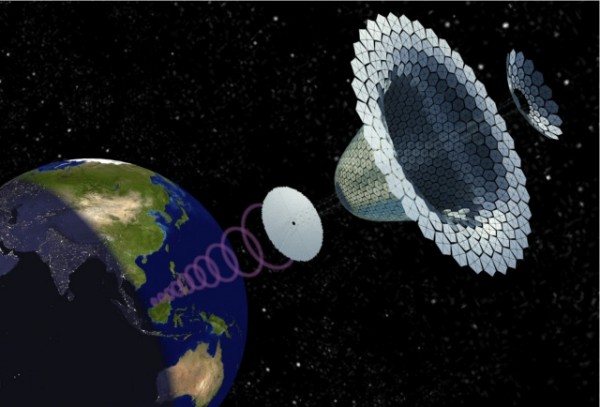

Every hour the earth receives so much solar energy, more than earthlings use it in a whole year. One way to harness this energy is to build giant solar farms that will collect some of the high-intensity, uninterrupted solar radiation.
Huge mirrors will reflect the sun's rays onto smaller collectors. This energy will then be transmitted to the earth using microwave or laser beams.
One of the reasons why this project is at the idea stage is its enormous cost. Nevertheless, it may become a reality not so long ago due to the development of gel technologies and a decrease in the cost of transporting cargo into space.
Burning trash, we get energy
Another method, which is already being used in Japan, is the creation of incinerators. Today they are built in England, Italy, Denmark, Germany, France, the Netherlands and the United States, but only in Japan these enterprises began to be used not only for their intended purpose, but also for generating electricity. Local factories burn 2/3 of all waste, while the factories are equipped with steam turbines. Accordingly, they supply heat and electricity to the surrounding areas. At the same time, in terms of costs, it is much more profitable to build such an enterprise than to build a CHP.
The prospect of using the Earth's heat where volcanoes are concentrated looks more tempting. In this case, it is not necessary to drill the Earth too deeply, since already at a depth of 300-500 meters the temperature will be at least twice the boiling point of water.
There is also such a method of generating electricity as hydrogen energy. Hydrogen - the simplest and lightest chemical element - can be considered an ideal fuel, because it is found where there is water. If you burn hydrogen, you can get water, which decomposes into oxygen and hydrogen. The hydrogen flame itself is harmless, that is, there will be no harm to the environment. The peculiarity of this element is that it has a high calorific value.
Countries using the heat of the planet
The undisputed leader in the use of geo-resources is the United States - in 2012, energy production in this country reached 16.792 million megawatt-hours. In the same year, the total capacity of all geothermal plants in the United States reached 3386 MW.
Geothermal power plants in the United States are located in the states of California, Nevada, Utah, Hawaii, Oregon, Idaho, New Mexico, Alaska and Wyoming. The largest group of factories is called "Geysers" and is located near San Francisco.
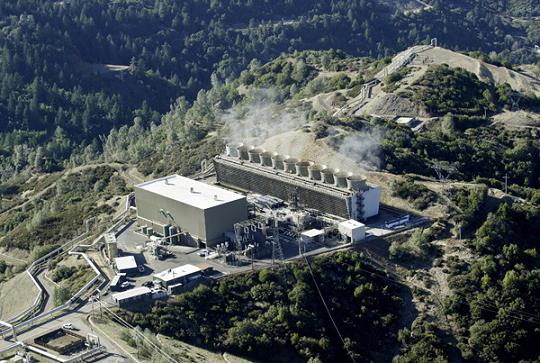

In addition to the United States, the Philippines, Indonesia, Italy, New Zealand, Mexico, Iceland, Japan, Kenya and Turkey are also in the top ten leaders (as of 2013). At the same time, in Iceland, geothermal energy sources provide 30% of the country's total demand, in the Philippines - 27%, and in the United States - less than 1%.
What's in the future?
Of course, the energy of the Earth's magnetic field or that which is obtained at nuclear power plants cannot fully satisfy all the needs of mankind, which are growing every year.However, experts say that there are no reasons for worries, since the planet's fuel resources are still enough. Moreover, more and more new sources, environmentally friendly and renewable, are being used.
The problem of environmental pollution remains, and it is growing catastrophically. The amount of harmful emissions goes off scale, respectively, the air we breathe is harmful, the water has dangerous impurities, and the soil is gradually depleted. That is why it is so important to timely engage in the study of such a phenomenon as energy in the bowels of the Earth, in order to look for ways to reduce the demand for fossil fuel and more actively use unconventional energy sources.
How to get geothermal energy and where is it used
The most natural way to use geothermal energy is to use it for heating. The principle of operation and equipment of such a thermal station remain practically unchanged, the difference lies in the absence or reduced power of the boiler for heating water and the need for chemical purification of thermal water, often containing active impurities, before it is directed into the heating pipes. So, in our country in the Krasnodar Territory there is a whole village (Mostovskoy), heated exclusively by geothermal sources.
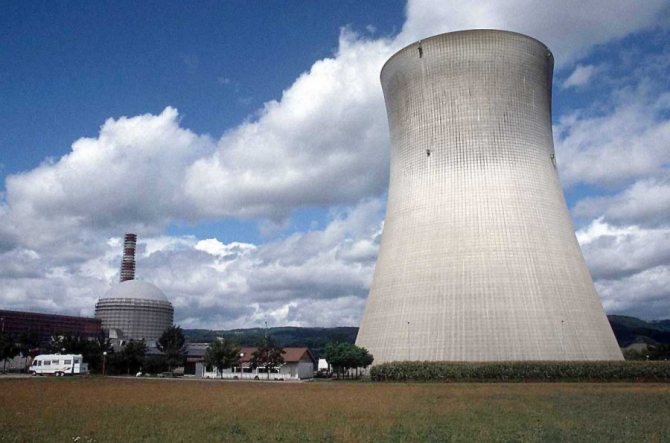

At a sufficiently high temperature of thermal water, it can be used to generate electricity on the principle of thermal power plants. In the simplest case, steam generated directly from the thermal source is fed to the turbine. If the temperature of the thermal water is too low for intensive formation of the steam rotating the turbine, it is additionally heated.
If the temperature of thermal water is insufficient for intensive evaporation, the so-called binary principle can also be applied: hot thermal water is used to heat and evaporate another liquid with a low boiling point, such as freon, which forms the working steam that rotates the turbine. This principle is embodied in Russia in an experimental installation that is part of the geothermal complex in Kamchatka.
